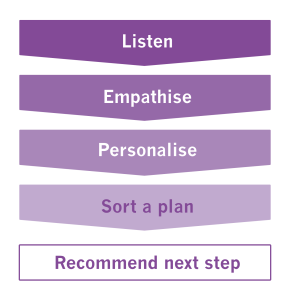Fewer words, better said
Recently we had a carpet fitted, in an upstairs room with lots of oddly shaped corners and angles. The two-man team who did it were brilliant – it never ceases to amaze us how easy things look when they’re done by people with skill. Carrying the rolls of carpet and underlay upstairs, they commented on the Lambert ‘staircase library’ – a somewhat unique invention, featuring books of all shapes, sizes and topics stacked on every step. (Funny how you assume the things your own household do and say are the same for everyone!)
The young lad asked what the books were about, which began a conversation in which he said that he couldn’t read. Honestly, it stopped us in our tracks and made us realise how easy it is to make generalisations and judgements about others. He was a great carpet fitter, a friendly and respectful tradesman and interesting company. The fact that he couldn’t read did not detract from any of that, and his colleague took care of all the paperwork which meant that his literacy levels had very little impact on his working life.
But he couldn’t read, and we’d automatically assumed he could.
Read all about it… adult literacy rates
Having done a bit of research since, we discovered that adult literacy rates across the UK vary, with:
· One in four adults in Scotland experiencing challenges with reading (26.7%)
· One in five in Northern Ireland (17.4%)
· One in six in England (18%)
· One in eight in Wales (12%)
That’s a staggering 6.6 million people who struggle to read and comprehend written texts. Think how many of those will have pets, how many could be clients of your practice.
It raises all sorts of interesting questions for veterinary professionals. How can we get informed consent if clients can’t read and understand the forms we ask them to sign? How can we expect first time pet owners to know about worming and vaccination regimes if they can’t read our websites? How much more complicated are we making the paperwork we routinely use, with the inclusion of jargon? Using plain English is just plain common sense.
Choosing words carefully
At Onswitch we talk a lot about recipient design in our training courses, the principle of adapting the tone, content and methods of communication to the needs of the person we’re communicating with. We sum it up as ‘fewer words, better said’.
If you want clients to follow your care plans, and trust your recommendations, it’s so important to consider the words and phrases you choose in conversations and on written materials. Research consistently proves that the words we use make a massive difference in the outcome of the conversation. A study in the human medicine field by Heritage et al (2007) found that changing just one word in a conversation delivered a statistically significant uplift in the number of patients reporting all their concerns.
Communication is a two-way process of course, so it’s equally important to listen as well as speak. I love the old saying that we have two ears and one mouth, and we should use them in those proportions. Only by hearing our clients’ concerns can we demonstrate that we understand their unique situation and recommend a clear plan, tailored to achieving the right outcome.

If you’d like to sharpen your communication skills, Onswitch run regular workshops through the year. You can find out more, or book your place on one, here.
We can design and deliver bespoke training for your practice team too, so why not get in touch for a chat?

